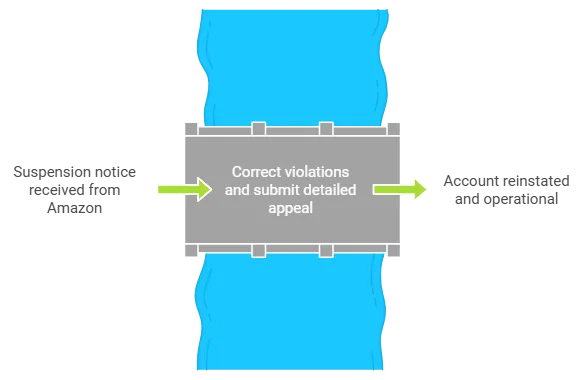Best Practices to Prevent Counterfeit Claims on Amazon
Best Practices to Prevent Counterfeit Claims on Amazon
Counterfeit claims are among the most serious issues that Amazon sellers can face. When a customer or brand owner reports that a product being sold is counterfeit, Amazon acts quickly to protect its marketplace. The consequences often include listing suspension, listing removal, or even permanent deactivation. For sellers, these claims can be devastating if not handled correctly.
In this article, we’ll explore what constitutes a counterfeit claim on Amazon, why it’s such a critical issue, and how sellers can prevent these problems. We’ll also discuss strategies for handling reinstatement if your listing is suspended due to counterfeit claims.
What is a Counterfeit Claim on Amazon?
A counterfeit claim arises when a product sold on Amazon is alleged to be a fake or unauthorized copy of an original brand. Amazon defines a counterfeit item as one that imitates or reproduces the brand’s trademarked products without permission. Counterfeit claims can originate from customers, brand owners, or even Amazon itself through automated checks.
Example: If a customer purchases a high-end watch from your listing but believes it is not genuine based on its quality or packaging, they may file a counterfeit claim. Similarly, if a brand owner detects unauthorized replicas of their products being sold, they can report the listings to Amazon, which may trigger listing deactivation or listing suspension.
Why Counterfeit Claims Lead to Listing Suspensions
Amazon enforces strict anti-counterfeiting policies to protect both customers and brand owners. Counterfeit claims undermine the integrity of Amazon’s marketplace and erode customer trust. Amazon’s response to these claims is swift to avoid potential damage to its reputation.
If Amazon detects or receives multiple complaints about counterfeit products, it may initiate an investigation into the seller’s listing. This could result in listing removal, listing suspension, or permanent deactivation depending on the severity of the issue. Additionally, Amazon may withhold funds during the investigation, impacting cash flow and business operations.
Common Causes of Counterfeit Claims
There are several reasons why sellers might inadvertently face counterfeit claims. Here are the most common causes that lead to suspensions or deactivations:
1. Sourcing Products from Unauthorized Suppliers
One of the most frequent causes of counterfeit claims is sourcing inventory from unauthorized suppliers or distributors. Even if a product is genuine, not having proper documentation or purchasing from unverified sources can lead to claims of counterfeit goods.
2. Selling Grey Market or Parallel Imports
Grey market goods, also known as parallel imports, are genuine products imported without the permission of the brand owner. These products are not necessarily counterfeit, but they are unauthorized and may lead to claims if they differ in packaging, warranty terms, or quality standards.
3. Inadequate Documentation
Failing to maintain clear documentation proving the authenticity of your products, such as invoices, letters of authorization (LOA), or certificates of authenticity, can put you at risk. Amazon requires sellers to be able to provide this documentation to defend against counterfeit claims.
4. Unintentional Misrepresentation of Product Authenticity
In some cases, sellers may unknowingly sell counterfeit or unauthorized products due to lack of verification. This can occur if sellers rely solely on third-party distributors without proper vetting, leading to counterfeit claims from customers or brand owners.
How to Avoid Counterfeit Claims on Amazon
To protect your listing and prevent suspensions, it’s crucial to adhere to Amazon’s guidelines and take proactive measures to avoid counterfeit claims. Here are some strategies to stay compliant:
1. Source Products from Authorized Suppliers
Work only with suppliers or distributors who have a proven track record and are authorized by the brand owner. Maintain up-to-date documentation, such as invoices, LOAs, and certificates of authenticity.
2. Verify Product Authenticity Regularly
Establish a system to periodically verify the authenticity of your products through direct communication with the brand owner or by inspecting packaging and product details. This helps reduce the risk of unintentionally selling counterfeit goods.
3. Maintain Proper Documentation
Keep clear and accessible records of all invoices, purchase orders, and letters of authorization to quickly provide evidence if Amazon requests it during an investigation.
4. Avoid Selling Grey Market Goods
Steer clear of sourcing or selling grey market goods, as they can lead to claims of unauthorized sales even if the products are genuine. Stick to authorized channels to minimize risks.
What to Do If Your Listing is Suspended for Counterfeit Claims
What to Do If Your Listing is Suspended for Counterfeit Claims
If your Amazon listing is suspended or deactivated due to counterfeit claims, it’s crucial to take prompt and decisive action to resolve the issue. Here’s a roadmap for handling reinstatement:

Example: A seller who faced suspension for counterfeit skincare products successfully reinstated their listing by sourcing only from brand-authorized suppliers, improving documentation practices, and submitting a comprehensive appeal. Their listing was reinstated within two weeks after demonstrating compliance.
Frequently Asked Questions (FAQ)
Frequently Asked Questions
Frequently Asked Questions
Yes, repeated or severe violations—such as selling counterfeit products intentionally or failing to provide documentation—can lead to permanent listing deactivation. To avoid this, strictly follow Amazon’s guidelines for sourcing and documentation.
The timeline for reinstatement depends on the severity of the violation and the thoroughness of your appeal. Minor issues may be resolved within a few days, while more complex cases could take several weeks.
If your appeal is rejected, carefully review Amazon’s feedback and address any unresolved issues. Submit a revised appeal with additional corrective measures or documentation to strengthen your case for reinstatement.
Protecting Your Amazon Business from Counterfeit Claims
Counterfeit claims can have severe consequences for your Amazon business, including listing removal, listing suspension, or even permanent deactivation. Sellers must stay vigilant by sourcing products from authorized suppliers, maintaining proper documentation, and verifying product authenticity regularly to protect their business and customers.
If your listing has been suspended due to counterfeit claims, taking prompt and well-documented action is essential to reinstatement. At Amazon Sellers Appeal by ASA Compliance Group, led by Or Shamosh, we specialize in helping sellers navigate Amazon’s complex compliance landscape and offer expert support for reinstatement. [Contact us today] to fast-track your listing’s reinstatement and keep your business running smoothly.









